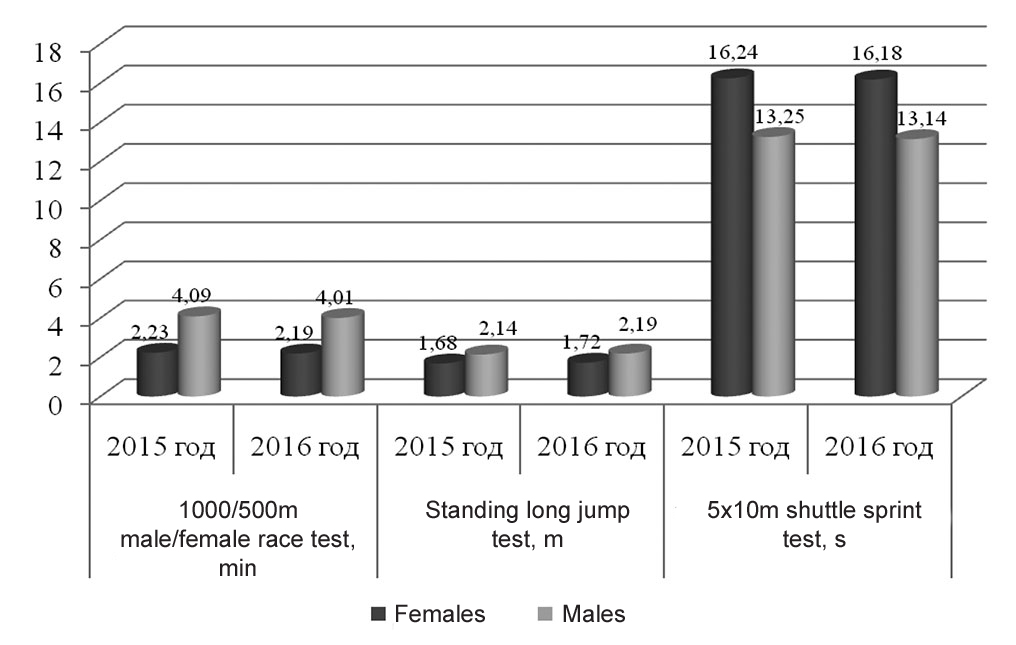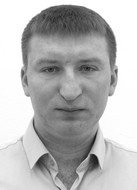West Siberian students; physical fitness rating tests
Фотографии:
ˑ:
PhD O.V. Zlygostev1
PhD, Associate Professor S.A. Tatyanenko1
1Tobolsk Industrial Institute, branch of Tyumen Industrial University, Tobolsk
Keywords: students, tests, sport fitness, speed-strength abilities, coordination abilities, endurance.
Background. In the context of challenging socio-economic situations a growing priority is given to physical fitness of modern specialists in different professional fields. The expanding habitual physical inactivity is clearly detrimental to young people’s health and, hence, to their academic and professional progress and careers [3, 5, 6]. The efforts to improve the students’ working ability in the academic educational process are largely limited by their initial physical fitness level as a part of their individual health statuses [1, 2, 4], with the academic physical education system improvement projects designed to test physical fitness on a systemic basis.
Objective of the study was to rate physical fitness of the West Siberian students.
Methods and structure of the study. The study was performed in the period of 2014 through 2017, with 1,476 Tyumen region students of both sexes being subject to the study. The university students’ physical fitness was rated by a set of standard tests commonly applied by academic Physical Education teachers. Speed-strength abilities were rated by the standing double-leg long jump test; coordination abilities were rated by the 5х10m shuttle sprint test; and endurance was rated by the 1000m/500m race tests, respectively.
Study results and discussion. In the 1000/500m gender-specific race test prior to the academic year of 2015 the male/ female groups finished with 4.09±0.32/ 2.23±0.16min on average, respectively, versus the post-2016 tests where they showed a significant progress with 4.01±0.30/2.19±0.14min on average, respectively (р>0.05, see Figure 1).
In the speed-strength rating standing long jump test, the male/ female groups scored 2,14±0,16/1,68±0,12m and 2.19±0.20/1.72±0.13m prior to and at the end of the academic year, respectively (р>0.05).

Figure 1. Physical progress rates of the West Siberian university students
In the coordination ability rating 5x10m shuttle sprint test, the male/female groups scored 13.25±1.04/ 16.24±1.14s and 13.14±1.01/ 16.18±1.16s on average prior to and at the end of the academic year, respectively (р>0.05).
It should be noted that the physical fitness rates in the male group were found higher than in the female group that is explainable by the natural progress rates of the male and female bodies in ontogenesis. Having compared the study data with the findings of some other study reports [2, 3], we found that the university students of the Tyumen region show notably lower endurance, speed-strength and coordination ability rates than, for instance, their peers from the Central Federal Area. This gap might be due to the notable differences in the assets and financial situations in the regional universities and in the climatic conditions with the relevant limitations for physical practices in the northern areas.
Conclusion. Academic physical training systems are in growing priority at national educational establishments for the reason that good physical fitness is considered an important prerequisite for success in the academic educational process and professional careers. The initiatives to improve the physical and athletic fitness of the West Siberian university students shall be designed with due consideration for the actual assets and financial situations at the universities with a special emphasis on a broader engagement of the regional young residents into self-reliant academic and leisure-time practices. The study data gives the means to put the academic physical education process planning on a more specific basis to improve the process efficiency.
References
- Baronenko V.A. Zdorovye i fizicheskaya kultura studenta [Student's health and physical culture]. Moscow: Alfa-M publ., 2006, 352 p.
- Guba V.P., Rodin A.V., Moiseenkov G.A., Bogdanov N.N. Valeologicheskie osnovy «pasporta zdorovya» kak individualnoy zdorovesberegayuschey tekhnologii v sisteme vysshego pedagogicheskogo obrazovaniya uchascheysya molodezhi [Valeological foundations of health certificate as individual health-protecting technology in higher pedagogical education system for students]. Izvestiya Smolenskogo gosudarstvennogo universiteta, 2008, vol. 2, pp. 170-178.
- Guba V.P., Parfenenkov V.V., Guba V.P. Nauchno-prakticheskie i metodicheskie osnovy fizicheskogo vospitaniya uchascheysya molodezhi. Ucheb. posobie [Practical research and methodological basics of physical education of students. Study guide]. Moscow: Sovetskiy sport publ., 2008, 104 p.
- Guba V.P., Egorov V.N., Gryazeva E.D. Tekhnologiya otsenki zdorovya studentov gosudarstvennykh vuzov tsentralnogo federalnogo okruga rossiyskoy federatsii [Health rating technology for state university students in central federal district of Russia]. Izvestiya Tulskogo gosudarstvennogo universiteta. Fizicheskaya kultura. Sport, 2016, no. 1, pp. 29-36.
- Landa B.F. Metodika kompleksnoy otsenki fizicheskogo razvitiya i fizicheskoy podgotovlennosti. Ucheb. posobie [Methods for integrated assessment of physical development and physical fitness. Study guide]. Moscow: Sovetskiy sport publ., 2005, 192 p.
- Salov V.Yu. Teoreticheskie i metodicheskie osnovy formirovaniya zdorovogo obraza zhizni uchascheysya molodezhi sredstvami fizicheskoy kultury. Avtoref. dis. dokt. ped. nauk [Theoretical and methodological foundations for cultivation of healthy lifestyle among students by means of physical training. Doct. diss. abstract (Hab.)]. St. Petersburg: SAPhC publ., 2001, 55 p.
Corresponding author: oleg_zlig@mail.ru
Abstract
Objective of the study was to rate physical fitness of West Siberian students. The study was performed in the period of 2014 through 2017, with 1,476 Tyumen region students of both sexes being subject to the study. The university students’ physical fitness was rated by a set of standard tests commonly applied by the academic physical education specialists. Speed-strength abilities were rated by the standing double-leg long jump test; coordination abilities were rated by the 5х10m shuttle sprint test; and endurance - by the 1000m/500m race tests, respectively. The long-term test program joined by many students made it possible to rate their academic progress in the speed-strength, coordination ability and endurance building domains. The study findings have been successfully applied in the academic physical education improvement initiatives at the universities of the Tyumen region.


